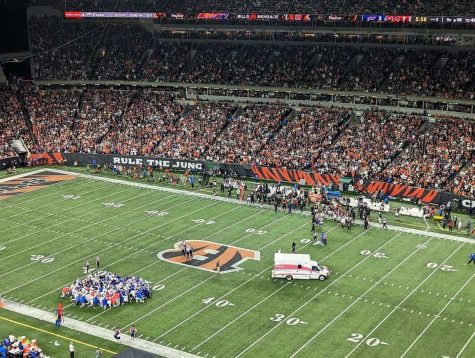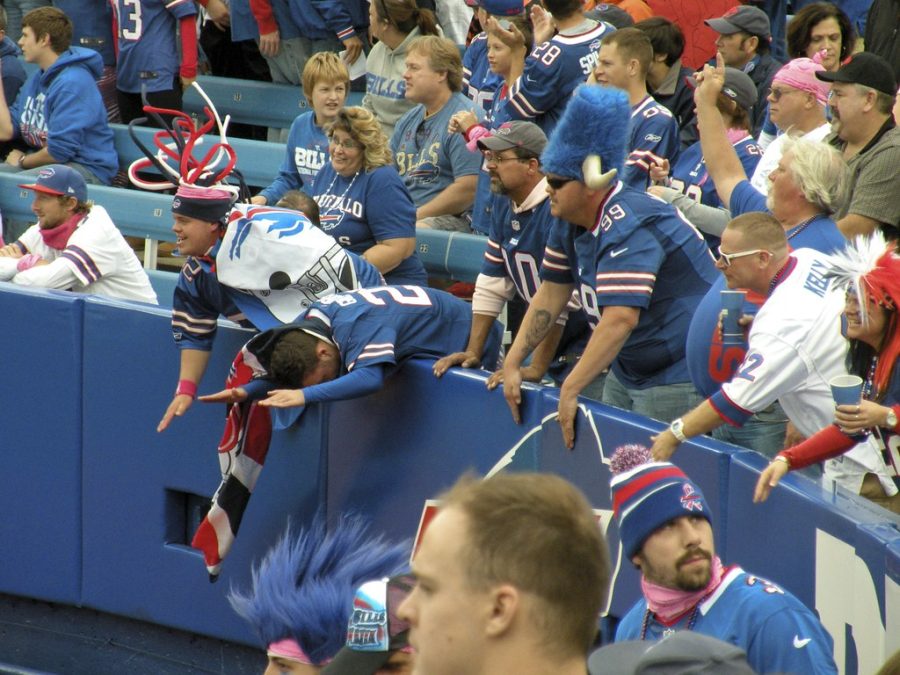Opinion: Damar Hamlin’s injury shook the football world, will it spark a change?
Will Monday night’s events be a reckoning for the NFL, or will we get more of the same?
Buffalo Bills fans at a game in Ralph Wilson Stadium, Buffalo, New York. Photo courtesy Matthew D. Britt/Flickr
On Monday, Jan. 2, the Cincinnati Bengals and the Buffalo Bills were playing a pivotal late regular season game that was aired on primetime TV. But the game took an unexpected turn, and hearts everywhere dropped when they saw 24-year-old Damar Hamlin suddenly collapse on the field from cardiac arrest.
After what appeared to be a hard but relatively routine hit in the NFL, Damar Hamlin’s sudden cardiac arrest following the play required medics to administer CPR and he had to be rushed to the hospital. As of Thursday, Jan. 4, Hamlin currently remains in intensive care at the University of Cincinnati medical center. Thankfully, his condition has slowly improved since Monday, even responding to doctors orders despite being critically ill.
It was a surreal sight. The crowd was frozen and silent. An ambulance drove onto the field and players from both teams were seen crying in an outpour of emotions for a fellow player. The game has since been canceled entirely.
Following Monday night’s events, the typical excitement of America’s game drawing closer to its climactic conclusion, with Super Bowl LVII next month, things have slowed down in an unprecedented manner. The focus, rightfully so, is on Damar Hamlin’s health.
In football, the risk of injury has always been high, from minor injuries to career ending or life-threatening injuries. It is a risk that high school and college players who dream to play in the NFL realize and are willing to take everyday when they wake up and go to practice.
An injury to a key player could cost your team a game or playoff aspirations, maybe even a championship. An injury could set you up with a bad knee for life or spoil your dreams of making it to the professional level. In the case of Damar Hamlin and countless others, an on-field injury has put their lives at risk. Sometimes, it’s bigger than football.
The handling of Hamlin’s injury on the field was swift and absolutely crucial. Canceling the game was certainly unprecedented for the NFL. For once, the severity of the situation was recognized and generated a worthy response, albeit, amidst the worst of circumstances.

The Buffalo Bills huddle for a team prayer (bottom left) as an ambulance takes their teammate, Damar Hamlin, to the hospital (center), at Paycor Stadium in Cincinnati, Ohio, on Monday night. Photo courtesy Schetm/Wikimedia Commons
The unfortunate reality of the situation is that whatever comes out of it, for better, for worse or nothing at all, it was at the cost of the safety of players like Hamlin and other former players whose traumatic on-field injuries have ended their careers, and in many cases, taken their lives. The NFL’s handling of this situation has been written by the blood, sweat and tears of former players and their families who have had to endure these unfortunate circumstances.
Going forward, any possible changes in how the NFL treats its players and their well-being will have been prompted by the dozens of cases of former players suffering from horrible injuries. If action is taken by the NFL, it will be because of the possible economic implications of having a player nearly die on the field on national television, and as youth football programs across the country have been suffering from declining participation rates. This decline in youth football participation has been largely because of parents concerned for the health of their kids, according to a study by the Ohio State University.
Still, the outpouring of support by fellow players and fans alike for Hamlin has been heartwarming, but it is just the latest of the many instances of on-field injuries in the NFL and is a rare moment of competence for a league that has historically shown an unwillingness to address this issue appropriately.
This same season, a string of scary head injuries suffered by Tua Tagovailoa, also a 24-year-old, has many observers concerned for his well-being. Many were justifiably outraged by the lack of urgency to better handle and prevent injuries such as the one suffered by the Miami Dolphins quarterback.
Tagovailoa’s string of head injuries started back in Week 2 when the Dolphins went up against the Buffalo Bills. During the game, Tagovailoa was sacked and hit his head hard on the grass. While attempting to jog back to the sideline, Tagovailoa stumbled and fell, only to be helped off the field by one of his offensive linemen. His head injury ruled him out for the rest of the game and Tagovailoa walked himself to the locker room. The game carried on following his injury, with the Dolphins squeezing out a 21-19 victory.
The injury was originally reported to be a head injury, thus putting Tagovailoa into the NFL’s concussion protocols ruling him out to play the following week, but immediately following the game, Dolphins head coach Mike McDaniel quickly refuted these claims in the post-game press conference, saying that Tagovailoa’s injury was to his lower back, refuting the earlier reports that it was a head injury.
Then, just four days later, Tagovailoa was on the starting roster for the Dolphins’ Week 3 Thursday night game against the Bengals. Tagovailoa would suffer another head injury during this game, one which prompted many to ask, “Why was he even playing in the first place?”
Tagovailoa’s injury was horrifying to watch. At that moment, many may have felt a similar anxiety to how they felt this past Monday. Yet, shortly after he was stretchered off the field, the game resumed and finished as scheduled. The Bengals would go on to win the game 27-15. After two head injuries in less than a week, Tagovailoa was finally placed into the NFL’s concussion protocol.
A third injury suffered by the Dolphin’s quarterback during a Week 16 Christmas day game against the Green Bay Packers, however, has once again landed him in the concussion protocol.
The NFL Players Association has since launched an investigation into how the Miami Dolphins have handled Tagovailoa’s injuries, especially since he had reported symptoms of a concussion on the Monday following their Week 15 game.
The handling of these situations has made two things apparent. First, the NFL treats its players as assets, not as humans. Second, the NFL sweeps every possible criticism relating to any controversial issue under the rug as quickly as it can, only giving into the pressure once it threatens their bottom line.
Tagovailoa and Hamlin are two sides of the same coin. Tagovailoa is a star quarterback, drafted fifth overall in the 2020 draft out of the University of Alabama who will make an average of $7,568,860 per year, over four years, according to Spotrac. Hamlin, on the other hand, was drafted in the sixth round of the 2021 NFL Draft out of the University of Pittsburgh and brings home an average of $910,119 per year, over four years, according to Spotrac. Despite these differences, both of them have fallen victim to the same problem, the NFL’s blatant disregard for the safety and well-being of those most important to the sport, the players.



